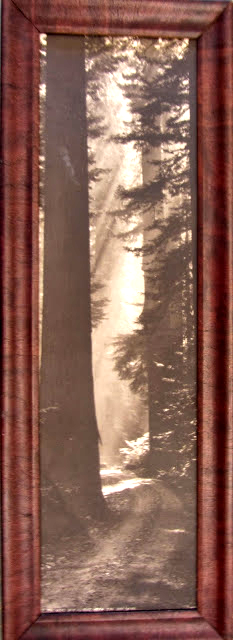We're committed to helping you
Circuit Panorama Camera - 1897
As a senior at
Stanford University, Arthur C. Pillsbury decided his senior project in
Mechanical Engineering would be to design a circuit panorama camera.
Pillsbury commented in his autobiography on this, saying,
" Bicycle days led to athletic goods + cameras, and a class rush of which I made some 60 snap shots in an hours time, was the beginning of a life time in all kinds of photographic work.
Scenic pictures of the Stanford Quad, Yosemite, Tahoe, and of California, designing and building the first revolving lense panarama camera, which looked like half a wash tub and made a picture 10 x 36 inches taking in almost half a circle, this new style of photography at once sprang into favor, it was especially good for mountain work or comprehensive views of citys etc. It was a bulky outfit, would only take one picture and then required a dark room to replace the exposed film. Which meant an entire days climb in the mountains had to be recorded with just one chance, but it had many advantages in skilled hands that even the later patented cameras do not possess."
Pillsbury's style in reporting his invention rolls past the thinking which preceded deciding it would be useful to record the broad and vast stretches of vistas which had stunned so many as Americans moved West, and his own thinking on the usefulness of this invention exists today in a few conventional photos, this one below being an example of his attempt to capture more of the what was before him.
You can almost hear him thinking, "How do I get the viewer to see the full scope of this view?
The photo here is reproduced from his personal album, pre-1900, while a student at Stanford and was probably taken around 1895. The photos in the album were contact prints. Most of these were badly faded with age by the time we saw them in 1985.
None of the original panoramas, which would have dated from the time the camera was designed in 1897 exist today. But Pillsbury took the camera with him to the Yukon in 1898 and used it to record the opening of the mining fields there. VIEW PANORAMAS
These images still need to be cleaned up and restored,
but you can see how they must have impacted the viewer at the time. They reach out to you with their motion and immediacy.
On April 18, 1906, Pillsbury used the camera to record the first day of the San Francisco Earthquake, showing the monumental destruction caused first by the quake itself and then the impact of fire on the city.
Later, Pillsbury built another circuit panorama camera which took vertical views and many of these images were also produced as scenic views of the Yosemite, capturing as other cameras could not, the magnitude of that national treasure.
Giant Redwood (Sequoiadendron giganteum) with crespuscular rays
Title, "The Road Winds out into the Sun Shine", ca. 1906
Arthur Clarence Pillsbury (1870-1946)
Orotone Photograph
Image from Jeanette Hyden



